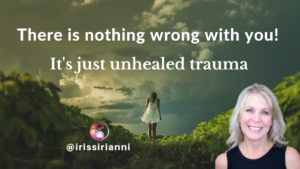There is nothing wrong with you. It’s just unhealed trauma.

Relationships are the opportunity to have life long learning and growth.
Relationships are great when they’re great until they aren’t, and that’s your opportunity to see what’s going on below the surface of the iceberg.
If you have anxious tendencies in your relationships this is when your triggers are activated and this is also the point when anxiousness and anxiety really start to bubble up to the surface. This is when your nervous system kicks into overdrive. This is when you become hyper-vigilant about what your person is up to and you start with protesting strategies to keep them close to you.
Some of the protesting strategies may include:
- excessive calling or texting,
- giving the silent treatment,
- acting hostile; rolling eyes, looking away when they speak,
- threatening to leave,
- ignoring calls, saying you have plans when you don’t, and
- keeping score; it took them 30 min to call/text me back, I’ll wait that long to call/text them back.
If this resonates with how your relationships go I want to reassure you that this is a subconscious pattern that was created to protect yourself from the uncertainty and fear of being abandoned or rejected by a partner.
This is an example of unhealed trauma and when another relationship breaks your heart it’s impossible not to wonder what’s wrong with you but it’s not you, it’s the trauma.
How to heal the trauma?
What’s below the surface of the iceberg is fairly massive so if you were to chip away at it, it could be a bit of work but it would be a worthwhile thing to do to start healing, right? Healing isn’t a step-by-step process; first do this, then that, then these next few things, and Voila! Healed. No-no-no. If it were that easy everyone would do it, right!
Trauma is layered because there is the initial trauma (usually childhood but not always), then there are the life experiences that are layered on top of it which buries it deeper and deeper within.
You can see that there is a bit of work to discover where you want to start and where you start depends on a few things (not an inclusive list by any means):
- Having the awareness that there is something that needs healing
We will stay in denial that there is something within us that is contributing to the unhappiness in our love life and really any area of our life because it’s all connected.
- Being open to the understanding that you cannot heal in a silo and will need help from others; someone who has done their own healing and has helpful information of their process, energy work, therapy, attending workshops, reading books, watching helpful videos, etc.
So often we want to try and figure it out on our own. There is a saying, ‘you can’t solve a problem from the same mindset that created it.’ There is information that is just not available for you to resolve the trauma on your own so outside help is necessary.
- Being open to start the process
This is a good one and a lot of people are stuck here for a very long time. They know they need to do the work and they talk a lot about their pain but havent reached a point where they are ready to start the process.
- How much emotion you are able to deal with as things come to the surface
There will be pain. There will be tears. There will be anger. How much one is able to hold and allow to be released before shutting down or numbing the pain is also part of the process.
- What’s in your toolbox to help you
We need the right tools in our toolbox to fix things. Some tools can be used together but a hammer won’t fix everything. The same applies to healing. We acquire new tools all the time,
* Yoga Nidra to calm the nervous system,
* meditation and breath work to be in the moment,
* positive affirmations to reprogram the subconscious mind,
* body awareness and detachment from past events as if they are happening now,
* self-hypnosis,
* rapid eye movement to help process a traumatic event,
* cognitive behaviour to address emotional challenges, and
* tapping to decrease the intensity of feelings and emotion, are just a few.
The more tools you have available, the easier the integration and healing is.
- Your level of emotional maturity
Emotional maturity happens in baby steps. At each stage in the healing process we need to feel safe again. We become stronger – like a muscle – and just when we have settled in and feel good, the next experience will show up that triggers us again and we start the healing process using the tools we have learned along the way. We grow in self-awareness and maturity.
Wherever you are on your journey is exactly where you need to be right now.
For years I wondered what we were supposed to heal from. Other than a physical illness I couldn’t wrap my head around that anything else needed healing. My perspective was that I was unlucky in love, that relationships don’t work for me, and I’m always being taken advantage of. It never occurred to me that I had trauma that needed healing. Honestly, there is always something to work on but the tools help you process much quicker.
If you need help in your healing process and would like to learn more about how my work can help you, click here to book a complimentary assessment.
With love,
Iris
Photo credit: Photo by Matthew Henry on Unsplash
